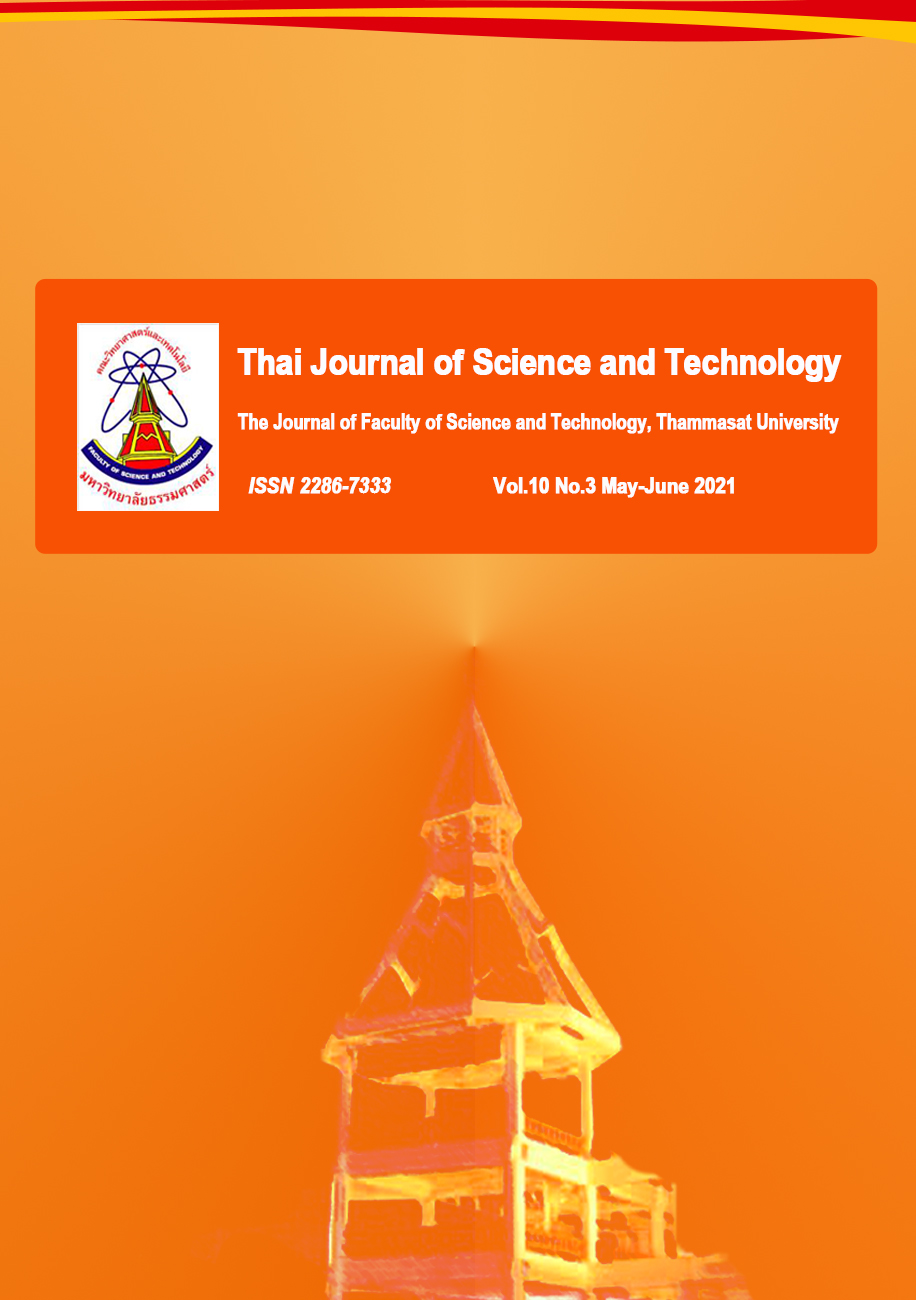Physicochemical and Functional Properties ofSilkworm Pupae Protein Extract
Main Article Content
Abstract
The objectives of this study were to investigate the optimum condition to extract protein from defatted silkworm pupae powder and investigate physicochemical and functional properties of that protein. The optimum pH value for extraction of silkworm pupae protein was 4.5. The protein extracted had yellow-orange color (Hunter L* 58.04 ± 0.47, a* 9.71 ± 1.31 and b* 38.58 ± 1.28) and 50.37 ± 0.72% in protein content. For functional properties of silkworm pupae protein, the result showed high protein solubility when pH value was more than 7. Foaming capability of silkworm pupae protein was the lowest but foam stability was the highest (p < 0.05), when compare with commercial whey protein concentrate and egg white powder. In addition, silkworm pupae protein showed the emulsion activity when pH value was greater or equal to 9.
Article Details

This work is licensed under a Creative Commons Attribution-NonCommercial-NoDerivatives 4.0 International License.
บทความที่ได้รับการตีพิมพ์เป็นลิขสิทธิ์ของคณะวิทยาศาสตร์และเทคโนโลยี มหาวิทยาลัยธรรมศาสตร์ ข้อความที่ปรากฏในแต่ละเรื่องของวารสารเล่มนี้เป็นเพียงความเห็นส่วนตัวของผู้เขียน ไม่มีความเกี่ยวข้องกับคณะวิทยาศาสตร์และเทคโนโลยี หรือคณาจารย์ท่านอื่นในมหาวิทยาลัยธรรมศาสตร์ ผู้เขียนต้องยืนยันว่าความรับผิดชอบต่อทุกข้อความที่นำเสนอไว้ในบทความของตน หากมีข้อผิดพลาดหรือความไม่ถูกต้องใด ๆ
References
AOAC. (1995). Official Methods of Association of Official Analytical Chemist. 16th edition, Washington DC: Association of Analytical Chemist.
Armstrong, W. D. (2009). Global demand for animal protein and its implications for the feed industry. Swine Nutrition Conference, 10th September, 2009. Indiana, USA.
Biasutti, R. A. E., Vieira, R. C. & Capobiango, M. (2007). Study of some functional properties of casein: Effect of pH and tryptic hydrolysis. International Journal of Food Properties, 10(1), 173 – 183.
Bradford, M. M. (1976). A rapid and sensitive method for quantitation of microgram quantities of protein utilizing the principle of protein-dye binding. Analytical Biochemistry, 72, 248–254.
Chatsuwan, N., Puechkamut, Y. & Pinsirodom, P. (2018). Characterization, Functionality and Antioxidant activity of water-soluble protein extracted form Bombyx mori Linn. Current Applied Science and Technology, 18, 83–96.
Felix, M., Bascon, C., Cermeno, M., FitzGerald, J. R., Fuente, de la J. & Carrera-Sanchez, C., (2020). Interfacial/foaming properties and antioxidant activity of silkworm (Bombyx mori) pupae protein concentrate. Food Hydrocolloids, 103, 1–10.
Johnson, T.M. & Zabik, M.E. (1981). Ultrastructural examination of egg albumen protein foams, Journal of Food Science, 46, 1237-1240.
Joopawang, P. & Sompongse, W. (2020). Effect of Pressure and Temperature on Fat Removal
of Silkworm Pupae (Bombyx mori L.) by Supercritical Carbon Dioxide Extraction. Proceeding of The 22nd Food Innovation Asia Conference 2020 (FIAC 2020), 18-19th June 2020, pp.83 – 89. BITEC, Thailand.
Kim, H. W., Setyabrata, D. Lee, Y. J., Jones, O. G. & Kim, B. H. Y. (2016) Pre-treated mealworm larvae and silkworm pupae as a novel protein ingredient in emulsion sausage. Innovative Food Science and Emerging Technologies, 38, 116–123.
Kinsella, J. E. (1982). Protein structure and functional properties: Emulsion and flavor binding effect, In Food Protein Deterioration, Washington, DC: American Chemical Society, pp.301–306.
Omotoso, O.T. (2006). Nutritional quality, functional properties and anti-nutrient compositions of the larva of Cirina forda (Westwood) (Lepidoptera: Saturniidae). Journal of Zhejiang University Science, B7, 51–55.
Osasona, A. I. & Olaofe, O. (2010). Nutritional and functional properties of Cirina forda larva from Ado-Ekiti, Nigeria. African Journal of Food Science, 4, 775–777.
Rumpold, B.A. & Schluter, O.K. (2013). Nutritional composition and safety aspects of edible insect. Molecular Nutrition and Food Research, 57(5), 802–823.
Sompongse, W., Morioka, K. & Itoh, Y. (2003) Comparison of Amino Acid Composition among Various Surimis and Washed Meats. Research Reports of Kochi University, Agriculture, 52, 33–38.
Wang, W., Wang, N., Zhou, Y., Zhang, Y., Xu, L., Xu, J., Feng, F. & He, G. (2011). Isolation of a novel peptide from silkworm pupae protein components and interaction characteristics to angiotensin I-converting enzyme. European Food Research and Technology, 232, 29–38.
Wu, Q. Y., Jia, J. Q., Tan, G. X., Xu, J. L. & Gui, Z. Z. (2011). Physicochemical properties of silkworm larvae protein isolate and gastrointestinal hydrolysate bioactivities. African Journal of Biotechnology, 10, 6145–6153.
Yi, L., Lakemond, C. M. M., Sagis, L. M. C., Eisner-Schadler, V., Van Huis, A. & Van Boekel, M. A. J. S. (2013). Extraction and characterization of protein fractions from five insect species, Food Chemistry, 14, 3341–3348.
Zhao, X., Vazquez-Gutierrez, J. L., Johansson, P. D., Landberg, R. & Langton, M. (2016). Yellow mealworm protein for food purposes - extraction and functional properties, PlOS One, 11(2), e0147791.
Zielinska, E., Karas, M. & Baraniak, B. (2018). Comparison of functional properties of edible insects and protein preparation thereof. LWT – Food Science and Technology, 91, 168–174.


